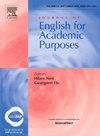The rhetorical organization of discussions sections of qualitative research articles in Applied Linguistics and the use of meta-discourse markers
Abstract
This study examined the rhetorical organization and the distribution of meta-discourse markers in a corpus of 20 qualitative research articles in the Applied Linguistics field. The findings of the study indicated that the seven-move structure proposed by prior research in quantitative datasets is also true in our qualitative dataset. Concerning steps, however, this study indicated that there are two new steps in the Comment on the Results move and also two new steps in the Deduction from the Research move, compared with the quantitative data of prior research. It was also found that both the distribution and frequency of meta-discourse markers indicate significant differences in comparison with quantitative research articles. Given these findings, we can say that although the schematic structure proposed for the Discussion sections of quantitative research articles is applicable to the qualitative corpus, it is also important not to ignore subtle nuances in the two research paradigms. Drawing academic writers' attention to these rhetorical and linguistic nuances arising from research paradigm differences can carry practical pedagogical implications. The findings of this study can raise novice writers’ awareness with respect to academic writing rhetoric and the functions of meta-discourse markers in qualitative research in Applied Linguistics.

 求助内容:
求助内容: 应助结果提醒方式:
应助结果提醒方式:


